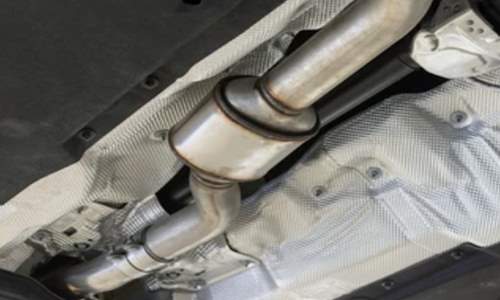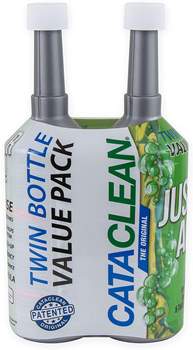
If anything is making you believe that you can cruise around with a bad catalytic converter, then it’s time to think again that driving with a bad catalytic converter is safe or not, this article is for you to help!
In case if you are having no cues for a bad catalytic converter such as loss of power, engine check light, the rotten egg-like smell from driving, you can drive some miles to reach an exhaust repair shop.
However, broken catalysts can be problematic! If the ceramic substrate gets damaged, it will reverse the toxic compounds into the cylinder. This will cause serious damage to the cylinder walls.
Unless the converter isn’t completely clogged, you can drive your car up to some miles. In case it gets completely clogged, the consequences would lead towards substantial performance reduction.
But what really happens when the catalytic conversion goes bad? Let’s start the discussion.
What Happens when the Catalytic Converter Goes Bad?
If the catalytic converter is bad it will produce rattling sounds with emission of rotten egg-like/sulfur smell at times.
With a bad CAT converter, the unit also stops catalyzing. A change in the exhaust sound might happen. However, other identifiers may include complex motor problems as well. Due to the deteriorating of the catalyzing element, a bad catalytic converter may increase or decrease backpressure. Consequently, the chunk of the converter may blow backward and clog the exhaust.
What Happens if You Keep Driving with a Bad Catalytic Converter?
In extreme cases, a bad converter can prevent you from driving your car. However, with a partially clogged converter, you can drive indefinitely, but there will be a significant drop in the performance.
Moreover, it is important to note that if you are living in an area where they keep an eye on emissions, it will be illegal for you to drive a car with a bad catalytic converter.
Despite the alarming clues for a bad catalytic converter, consistent driving can cause poor backpressure. This lack of backpressure can cause poor performance and can burn the valves as well. In most cases, a bad CAT converter causes poor gas mileage at first. Later, the problem extends up to degraded performance and loss of power and then it gets too late for any fix.
Thus, ultimately you would have to change the CAT converter. With further negligence, the damage may extend up to the muffler, and then you would have to change that as well.
How to Clean a Catalytic Converter?
CAT cleaners are the perfect way to clean catalytic converters. These are designed to be used in gas tanks thus to clean out catalysts.
Simply add the CAT cleaner to the fuel tank and let it run through the exhaust system to clean the catalytic converter. It is ideal to pour it in below quarter fill tank. It will make up the right concentration required to clean the CAT converter.
After pouring, drive your car for 15- 20 miles to run the cleaner to and fro. Once reached the suggested miles, fill up your gas tank again.
Are you looking for a CAT cleaner? Here’s one which works best for most cars.
Cataclean – The Original Liquid Science
This cleaner is approved by EPA which means you would be free of all legal charges for its usage. Moreover, it works in best compatibility with diesel hybrid and gasoline engines.
A one-time use can go for about 3 months without recurring issues. Indeed, a reliable fix instead of an expensive repairing process. See the Latest Price on Amazon.
How Long Is It Possible to Drive Without a Catalytic Converter?
Mainly, catalytic converters are for emissions, therefore, driving your car without a CAT converter won’t damage your car. Thus, if you are planning to remove the CAT converter, you can definitely drive without it.
The absence of a catalytic converter does not bring about any mechanical damage, however, the number of toxins you blow would increase by 20-30 times without a catalytic converter. Therefore, removing the CAT converter is considered illegal.
Driving without a CAT converter decreases backpressure in the exhaust system resulting in higher HP. Similar to the use of less restrictive mufflers, the higher the HP, the higher the noise.
How to Unclog a Catalytic Converter?
Before starting with the cleaning process, let’s understand how to know if the catalyst converter even needs to be cleaned!
If your engine light is flickering, then hook up a scan tool. If it says P0420, which stands for efficiency below threshold, then it confirms the problem with the catalytic converter.
However, in case an inefficient code pops up in the scanner, it comes up when you only lose 5% of converter efficiency. Thus, the remaining 95% of the efficiency is still intact, so only a little cleaning will fix it all.
Head up to the following methods to unclog CAT converter:
How to Unclog CAT After Removing?
Without any need to replace the catalytic converter, this method requires removing the catalytic converter.
Since CAT converters become extremely hot, they weld on themselves thus become hard to clean. But, this can be done by following a simple method.
- You need to take a bucket. Now, pour laundry detergent, soap in it, and then foam it up. After building a foamy solution, submerge the catalytic converter in it.
- Now, leave the converter soaked overnight. This will help in removing all the crud that’s stuck inside.
- Just like a honeycomb, catalytic converters have small spaces which get clogged up really easily.
- A quick cleaning process will make them open and functional. Thus, this process will fix all the bad CAT converter issues and will turn CEL (check engine light) off.
How to Unclog a Catalytic Converter Without Removing It?
The aforementioned process of “unclogging catalyst converter by itself” is one of the methods which can help in this regard. Didn’t it work out for you? No need to worry, let’s move through another method without removing the CAT converter.
- Firstly, make sure the gas tank is half full. Now for the cleaning purpose, add a gallon of thinner/cleaner to facilitate the process of unclogging.
- Now either you have to drive the car at a higher speed for 150 miles or so. Or else you can run the engine at about 2500 RPMs for approximately 30 minutes.
- Both tricks will help the cleaner to run through the converter. This process will burn the impurities in the catalytic converter and thus would make it work again.
What if Nothing has Worked for Your Car?
If any of the cleaning methods haven’t helped, you either need to replace the CAT converter.
Here are some of the brands that can help you through:
Walker Exhaust Catalytic Converter | MagnaFlow Catalytic Converter | Walker Universal Catalytic Converter |
This converter is EPA compliant. It’s ready to get installed with no requirement of break-ins. | It is recommended for universal usage. However, welding and fabrication would be required to perfect placement. | In contrast to the previous converter, it is based on a direct-fit design with no need for fabrication. |
The OE design of this converter perfectly matches the quality of the original converter. | This converter is based on the upgraded design with higher longevity thus comes with a warranty. | This converter also works greatly for CO2 emissions and is EPA approved. |
It is most commonly renowned for noise reduction in cars. | It does offer better gas mileage at an affordable price. | If you dealing with CEL, the converter works best to keep the engine light off. |
What Happens if You Start a Car with a Clogged Catalytic Converter?
A clogged CAT converter will result in a loss of power. It is because the dirt and debris from the front part of the converter (which is more prone to dirt) completely clog the second part of it.
If the CAT converter is blocked, the car won’t even start. With such bad enough clogging, the car will have a hard time starting. On starting, the car will make loud rattling noises followed by worse dangling noise as if something has broken off inside the catalytic converter. Do you know why?
It is because severe clogging restricts the flow of exhaust gases. The engine then does not rev up. Resultantly, a loud exhaust in the car is going to be due to a damaged leak in the converter.
Can a Catalytic Converter Unclog Itself?
Now that you have substantial information about catalytic converters, let’s get into understanding if the CAT converter can self-clean!
If the converter is broken and too clogged, the answer is NO. However, in case of small areas of contamination, a good long drive on the highway can get things hot enough to unclog the converter.
Ideally, an hour-long cruise at the speed of 65 works as the best method to unclog the CAT converter.
Is it Ok to Drive Long Distances with a Bad Catalytic Converter?
Let me be honest with you! Driving with a bad catalytic converter is never a wise choice to make. You can still drive with it, however, it is not recommended.
The CAT converter will damage the engine if it’s breaking up. Otherwise, you will only have to bear the risks associated with emissions. If you get caught in any certain area with legal restrictions, there could be heavy fines for violating state and federal laws for harmful emissions.
Is it illegal to Drive Without a Catalytic Converter?
It is important to note that a car will not pass the emission test without a catalytic converter. Only in case, the age of the car is exempted, you will be allowed to drive without it.
Yes, permanently removing catalytic converters is illegal in the US. However, in other parts of the world, where they don’t have any such inspections, you can drive without a catalytic converter.
In the US, removing a converter comes under violation of federal and state laws. Since CAT converter slows down pollution, thus it’s against the law to remove it.
Catalytic converters break down the hydrocarbons and cause lesser pollution. However, if you remove the converter from any modern-day car, it will not harm you, but instead, cause greater pollution.
Bottom Line!
The catalytic converter is an important component of your car. Even though with great tech advancement, they have become highly durable yet machinery is always prone to damage and faulty functioning.
Thus, before going for replacements, quick fixes for them can help you get back on happy driving. In case nothing works out for you, get your converter replaced, as driving without it isn’t a favorable choice to make.
Related Article: How to Tell if a Spark Plug is Misfiring




